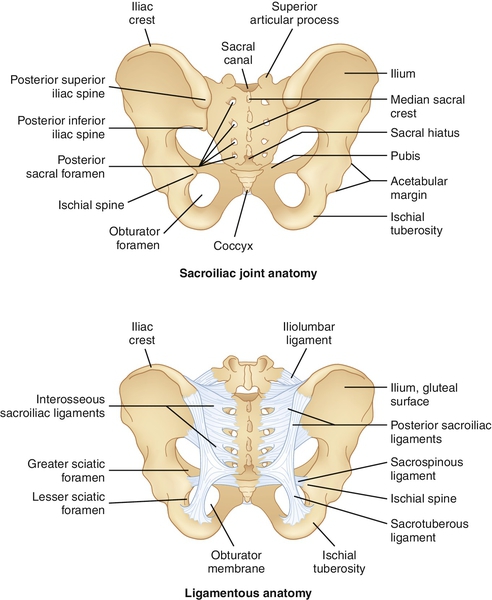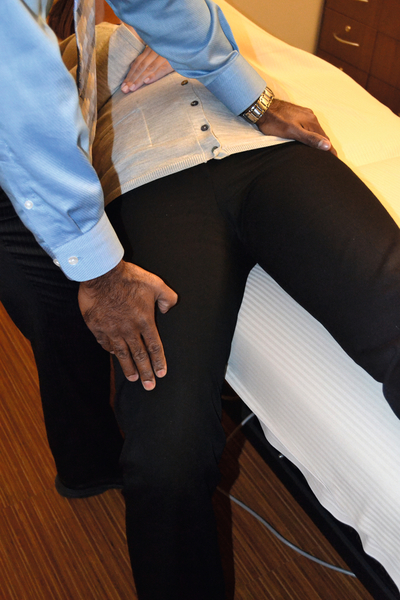CHAPTER 51
Sacroiliac Joint Dysfunction
Zacharia Isaac, MD; Richard Feeney, DO
Definition
Although chronic low back pain is more commonly attributed to the lumbar intervertebral disc and the zygapophyseal joints, the sacroiliac joint remains a significant cause of low back and buttock pain. However, diagnosis and treatment of sacroiliac joint dysfunction are a clinical challenge. The diagnosis of sacroiliac dysfunction should be considered only after careful exclusion of many separate distinct pathologic entities. Sacral fractures, sacroiliac joint inflammation (such as is seen with various seronegative spondyloarthropathies), metastatic disease, and even infectious seeding of the sacroiliac joint are but a few known pathologic conditions that deserve investigation. Imaging studies are often unhelpful and nonspecific in sacroiliac joint dysfunction. In addition, because of its redundant and variable innervation, sacroiliac joint dysfunction can be manifested with a variable pain referral pattern [1]. Thus, one must consider pathologic changes of neighboring structures sharing pain referral regions with the sacroiliac joint before deciding on the diagnosis of sacroiliac joint dysfunction.
The prevalence of sacroiliac joint dysfunction in those with low back pain complaints is thought to be between 10% and 25%, although during pregnancy the sacroiliac joint is the source of low back or posterior pelvic pain in 20% to 80% of cases [2]. As such, sacroiliac joint dysfunction may be more common in women than in men, and various studies demonstrate a female-to-male ratio of approximately 3:1 to 4:1 [1,3,4]. Moreover, in comparing causes of chronic low back pain, female gender and low body mass index are associated with sacroiliac joint dysfunction [5].
Adjoining the axial and appendicular skeleton, the sacroiliac joint occupies a critical biomechanical position (Fig. 51.1). It is thought that joint dysfunction occurs with structural change to the joint or positional changes relative to the sacrum and pelvis [6]. One can appreciate such changes in pregnancy-related instability [7] or with joint misalignment in adolescents, both of which are known sources of sacroiliac joint pain and dysfunction [8]. Pain associated with changes in position or the joint anatomy itself may be mediated by intra-articular, capsular, and ligamentous structures.

The sacroiliac joints are the bilateral weight-bearing joints that connect the articular surface of the sacrum with the ilium. The anterior and inferior third of the joint is synovial; the remainder of the joint space is syndesmotic. The sacroiliac joint is bordered on its ventral and superior edges by the ventral sacroiliac ligament and on its dorsal and inferior surfaces by the interosseous and dorsal sacroiliac ligaments. The articular capsule of the sacroiliac joint is thin and stabilized anteriorly by the ventral sacroiliac ligament. The strong extracapsular fibers of the dorsal sacroiliac and interosseous ligaments contribute principally to the stability of the joint. Further anchoring of the sacroiliac joint is conferred by the sacrotuberous and sacrospinous ligaments, which provide additional connections between the pelvis and sacrum. Innervation of the sacroiliac joint remains an area of active study, and differing descriptions of sacroiliac joint innervation exist. Anatomic studies have described innervation primarily through dorsal rami of spinal nerve roots L5-S4. However, recent studies indicate that the sacroiliac joint receives its innervation from the ventral rami of L4 and L5, the superior gluteal nerve, and the dorsal rami of L5, S1, and S2 or that it is almost exclusively derived from the sacral dorsal rami [9]. Yet others suggest that dorsal innervation to the sacroiliac joint is from the L5 dorsal ramus and the S1-S3 lateral branches, whereas the ventral innervation derives from the ventral rami of L4 and L5 [10].
The sacroiliac joint undergoes changes throughout life that affect the biomechanics of the joint. During childhood and adolescence, the joint is more mobile, absorbing forces throughout the gait cycle. With normal aging, the joints develop uneven opposing surfaces, and the joints are thought to gradually fuse in later years [11]. Movements around the sacroiliac joints are small in magnitude yet complex in nature. As body weight is transmitted downward through the first sacral vertebra, the sacrum is pushed downward and forward, causing its lower end to rotate upward and backward. Although there are no muscles that directly control movements around the joint, imbalance of the musculature surrounding the sacroiliac joint can affect stresses through the joint. Muscles anterior to the sacroiliac joint, including the psoas and iliacus, can influence movement of the sacrum [12]. Weakness in posterior muscles, such as the gluteus maximus and medius, can affect pelvic posture during weight bearing, thereby altering stresses through the joint.
Symptoms
By far the most common presenting symptom of sacroiliac joint dysfunction is low back and gluteal pain, which can be indolent and refractory to traditional interventions and therapies. Pain referral from sacroiliac joint dysfunction is not limited to the lumbosacral region or buttocks, however. Presenting complaints often include pain that is aggravated by prolonged standing, asymmetric weight bearing, or stair climbing. Pain can also stem from running, large strides, or extreme postures [13]. Because of the complex and extensive innervation of the sacroiliac joint as detailed before, dysfunction within the joint may be manifested with pain localizing to several rather removed regions, such as the thigh, groin, and leg. Sacroiliac joint dysfunction does not cause pain by neural compression. However, because of the anatomic proximity of spinal nerve roots to the lumbar and sacral plexuses, pain referral patterns can mimic a variety of neurologic pathologic processes. In a retrospective study of 50 patients with positive diagnostic response to fluoroscopically guided sacroiliac joint injection, investigators sought to characterize the most common presenting symptoms experienced by the cohort. The most common symptoms were buttock pain (94%), lower lumbar pain (72%), and lower extremity pain (50%). Pain in the distal leg and pain in the foot were also reported, as was low abdominal pain and groin pain [1]. Interestingly, the sacroiliac joint is recognized as the most likely source of low back pain after lumbar fusion [14].
Physical Examination
A thorough assessment of the low back, hips, and pelvis, including musculoskeletal and neurologic testing, is essential in isolating back pain caused by sacroiliac joint dysfunction and to exclude other common diagnoses. Examination should include measurement of leg length and assessment of pelvic symmetry by inspection of the posterior superior iliac spine, anterior superior iliac spine, gluteal folds, pubic tubercles, ischial tuberosities, and medial malleoli. The sacral sulcus is palpated and inspected with the patient prone, and any muscle atrophy in the gluteal muscles or distal extremity is noted. Atrophy in the limb implicates a lumbar radiculopathy more than sacroiliac joint syndrome. Palpation of the bony sacrum, subcutaneous tissues, muscles, and ligaments also helps to complete the examination.
Provocative tests have long been used by clinicians to differentiate sacroiliac joint–derived back pain from other regional pain generators. However, repeated clinical studies have suggested that when they are considered separately, the most commonly used provocative tests have low specificity for sacroiliac dysfunction [15–18]. One possible explanation for this is poor inter-rater reliability. Others suggest that both the minimal range of motion around the joints and the difficulty in simulating physiologic stresses through the joints make it more likely that provocative tests will elicit pain from surrounding structures [13]. Such structures include the lumbar intervertebral disc, zygapophyseal joint, and hip joint. Several investigators have shown that in the diagnosis of sacroiliac joint disease, a multitest regimen is more clinically useful than any isolated finding. Recent research suggests that three or more positive findings on provocative tests are 82% to 85% sensitive and 57% to 79% specific for sacroiliac joint disease [18,19]. There is some evidence, in fact, that patients with low back pain who point to the posterior superior iliac spine or within 2 cm from this landmark are more likely to respond to periarticular sacroiliac joint blockade, thus making the patient’s ability to pinpoint the pain a potentially useful tool.
Provocative Tests
Gaenslen Test
With the patient supine, lying close to the edge of the examination table with the buttock of the tested side over the edge of the table, the patient’s leg is dropped off the table such that the thigh and hip are in hyperextension. The contralateral knee is then maximally flexed. Pain or discomfort with this maneuver suggests sacroiliac joint disease, although a false-positive result can be seen in patients with an L2-L4 nerve root lesion [20], spondylolisthesis, sacral fractures, lumbar compression fractures, or spinal stenosis (Fig. 51.2).








